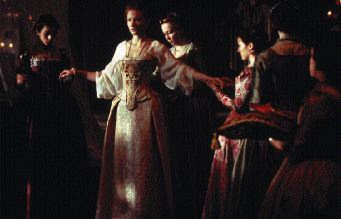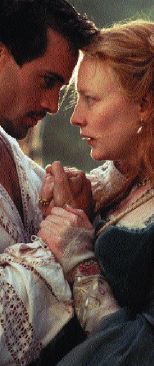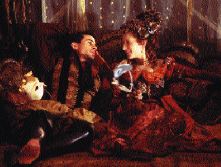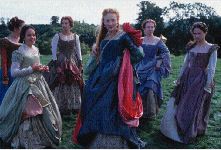Elizabeth A question of balance
Caught between the constraints of history and the self-interest of modernity a director wrestles with the tensions of period cinema. Kevin Hilton investigates the sound behind the throne
by Kevin Hilton
 Historical
drama has been a mainstay of the cinema since its creation
now a century ago. Film makers love ready-made stories and history is
packed with them; although the pressures of condensing real events into
those dramatic 90 minutes to two hours usually make the celluloid versions
more an entertainment than an education. As well as this balance, movie
directors know that they are attempting to recreate the past using modern
technology; their dilemma is whether to underplay the hardware or use
it to its full extent.
Historical
drama has been a mainstay of the cinema since its creation
now a century ago. Film makers love ready-made stories and history is
packed with them; although the pressures of condensing real events into
those dramatic 90 minutes to two hours usually make the celluloid versions
more an entertainment than an education. As well as this balance, movie
directors know that they are attempting to recreate the past using modern
technology; their dilemma is whether to underplay the hardware or use
it to its full extent.
Elizabeth is an example of the latter approach. It is costume drama yet the filming technique is unquestionably modern, making much use of moving cameras, extreme angles, jump cuts and digital audio. Dramatic, even sledgehammer use of sound is commonplace in the standard Hollywood blockbuster; an historical movie would normally feature clever yet almost imperceptible sound design--footsteps, ticking clocks, whispering corridors--rather than anything brash. Elizabeth is different: a full orchestra with choir fights against thundering hoofs, roaring flames that shoot through the cinema; traditional instruments vie with synthesisers; all the while an unsettling wind cries outside the echoing chambers.
As directed by Shekhar Kapur, the Indian director best known in the West for the controversial Bandit Queen, the story of the Virgin Queen's ascension to the throne of England and early reign is a mixture of dark intrigue and a bright youthfulness that gives way to staid duty. Kapur has said that he much admires Baz Luhrmann's updating of Romeo and Juliet, set in present-day Miami and shot with all the cinematic techniques available to a director, some of which Kapur saw as reminiscent of Indian cinema. Elizabeth may not be as brash as that Australian director's movie but it does share its visual zest, perhaps no accident as Gill Bilcock edited both.
The visual style in many respects dictated how the movie would sound. Mark Auguste, the supervising sound editor, says that while Kapur gave him pretty much an open brief, the pictures influenced the noises. 'Shekhar was very good, he didn't interfere at all,' he recalls. 'All he asked was for it not to be subtle, which is great for a sound editor. He talked more on a philosophical level, saying quite early on that he wanted it to be like an opera, so he was very broad with his ideas. He gave me total freedom and when I played him some of my early ideas, he expanded on them. In some ways the cutting of the film dictated how the sound would be. It's a modern cut with a constantly moving camera and that in a way made it very obvious what I had to do.'
Elizabeth's music score similarly fed off the images and provided another link back to both Baz Luhurmann and Australia, something reinforced by the casting of Cate Blanchett as Elizabeth and Geoffrey Rush as her ruthlessly loyal spymaster, Francis Walsingham. Composer and producer David Hirschfelder--who has had a long association with John Farnham and scored both Strictly Ballroom and Shine (the story of pianist David Helfgott, starring Geoffrey Rush)--was sent the script last year and met Kapur in London a day later.
'I actually came up with a piece from reading it through,' he told journalist Paul Tonks, 'but other than that there was no preparation. So I was really on the spot when they asked what I had in mind. I was saying all sorts, like period music, violins and some antiphonal styles reminiscent of the period mixed with modern styles. Shekhar saw right through it and described the scene from the end of the film where Elizabeth emerges with her powdered face and the wig. He described it very poetically and I heard three boy sopranos singing these notes: 3-note chords and a simple melody. I heard them so clearly and said, "Shekhar, I wish there was a piano here". He said, "There's one over there," so in a public place I left my eggs on toast and played for him. He said, "I like those notes," and I got the job.'
Music editor Mike Higham, who worked with Hirschfelder at the composer's own studio and Allan Eatons, an established film music studio in Melbourne, confirms the director's spontaneous way of working. 'Shekhar wanted a lot of choir-oriented stuff,' he says. 'A phrase he kept using was that he wanted a "mad monk" sound; he's an interesting guy, but I never quite understood him for the first three or four months of the postproduction process. A lot of film critics say that he works on the chaos theory and you have to go through the chaos to find out what he really wants.'
Both elements, which were worked on independently, saw the coming together of ancient and modern: period music alongside a modern orchestra with synthesisers and guitars overlaid; and modern sound effects, some processed through DSPs and samplers, placed under historical locations.
Auguste says that Kapur wanted powerful sounds that would emphasise the cutting. The effects also change during the movie, depending on the events being portrayed or the characters featured. In some respects, certain sounds are used like themes, just as a recurring music figure is identified with a mood or person. At the start of the film, there is much juxtaposition between the zealous, dangerous character of Queen Mary I ('Bloody Mary', played here by Kathy Burke) and the girlish figure of her half-sister Elizabeth, who is shown dancing in bright summer fields. 'The early scenes with Mary use a lot more low frequency and help build up this darker atmosphere,' explains Auguste. 'It's a very dark film overall but in terms of Mary we used a lot of sub-frequencies and room ambience, with interior backgrounds shot in cathedrals that were dark, some of which were manipulated by me to give the feeling we were aiming for.'
Scenes were shot on a mixture of sound stages at Shepperton Studios and real locations, including Haddon Hall in Derbyshire (which doubled as Hatfield House, Princess Elizabeth's home), Alnwick Castle, Warkworth Castle (doubling as the Tower of London) and Durham Cathedral. Ambient recordings were made at Liverpool Cathedral, which were sampled and played through a keyboard, with the pitch kept low and another ambient added to it. Auguste explains, 'I played the two together, one much lower than the other, giving some very deep low-frequency rumbles. There were even darker sounds used for the dungeon sequences, but once we were out of that, it lightens up.'
 A
sequence that is blatantly modern is Elizabeth preparing to face Parliament,
knowing that her continuing reign depends on winning out. Sharp cuts of
Cate Blanchett are interspersed with shots of the government chamber,
as the lords and bishops enter to argue against the Bill of Uniformity.
'The brief was to be adventurous,' says Auguste, 'almost to "suck" Elizabeth
into Parliament. It was also quite a good example of where David Hirschfelder
and myself amalgamated our efforts well. Even though we were working totally
separately, we were working towards the same sort of ideas. There were
many places where that happened, so we were on the same wavelength about
how to present the sound.' However, Auguste adds, being given the freedom
on this scene did make its own problems. 'The Parliament scene was quite
a maddening one to do because the dialogue is so important, inter-cutting
images of Parliament, and doors opening, and not trying to make it obvious,
the kind of trailer sounds approach with whooshes and bangs. What we came
up with is more subtle, getting the same effect and enveloping the audience
in what is happening.'
A
sequence that is blatantly modern is Elizabeth preparing to face Parliament,
knowing that her continuing reign depends on winning out. Sharp cuts of
Cate Blanchett are interspersed with shots of the government chamber,
as the lords and bishops enter to argue against the Bill of Uniformity.
'The brief was to be adventurous,' says Auguste, 'almost to "suck" Elizabeth
into Parliament. It was also quite a good example of where David Hirschfelder
and myself amalgamated our efforts well. Even though we were working totally
separately, we were working towards the same sort of ideas. There were
many places where that happened, so we were on the same wavelength about
how to present the sound.' However, Auguste adds, being given the freedom
on this scene did make its own problems. 'The Parliament scene was quite
a maddening one to do because the dialogue is so important, inter-cutting
images of Parliament, and doors opening, and not trying to make it obvious,
the kind of trailer sounds approach with whooshes and bangs. What we came
up with is more subtle, getting the same effect and enveloping the audience
in what is happening.'
Location sound was recorded on time-coded DAT by David Stephenson and then downloaded from a cutting room Sony PCM-7040 into an Avid PCI AudioVision. With the pictures edited on a Lightworks nonlinear system and the sound effects and dialogue on the AudioVision, an EDL was made, with an autoconform of the original material. The edit was originally based at De Lane Lea in London and then, after the third preview, when the picture was locked, work moved to Shepperton's Theatre 1 for the dub. Mark Taylor and Mike Dowson dubbed the SRD soundtrack on the room's Trident console, taking material directly from hard disk and mixing to 24-track Sony DASH.
Little dialogue replacement was necessary, as the location recordings were clean, with lines being rerecorded either to change a performance or to make identifying characters easier in some of the more complex scenes. 'There were some lines, especially early on in the sequences with Mary I and her courtier, the Earl of Sussex, that were replaced,' comments Auguste. 'That came out of some of the preview screenings, which said that we needed to make clear who some of the characters were, so we worked quite hard on that. The original recordings did help and that does make a difference.'
Surround sound is another modern movie-making technique, but Auguste says that it was not over-used on Elizabeth. 'Generally, background sounds are laid with similar sounding noises and spot effects are placed on top. We didn't go too mad with the surround but in certain cases we did fly things around the room, for example right at the start of the film with the burning of the martyrs, putting the flames over people's heads. As ever we were fighting the music in those dramatic scenes, although it's a pleasurable fight. There's always the problem of getting through because there is so much mid-range, which can get swallowed up. I think I still lost a bit this time,' he laughs.
The orchestral score was played by a combination of specially selected musicians from the Melbourne Symphony Orchestra and a group of instrumentalists who are described as 'more fringe' in style. The number of instruments varied between 50 and 76, the maximum number of players that could fit into Allan Eatons, which David Hirschfelder describes as being like 'a comfortable old shoe'. The main reason in using this studio rather than one in London was to be in his own environment (Shine was recorded here), working with a familiar team. Robin Gray recorded and mixed the orchestral sessions, some of which involved a 26-voice choir. Also involved on the sessions was Hirschfelder's own engineer, Chris Scallon.
 The
main orchestra was recorded on 24-track analogue, which was later
mixed down to a Dolby LCR mix on Tascam DA-88. Music editor Mike Higham
explains that in addition to the main orchestra, Hirschfelder wanted to
use synthesisers, guitars and other modern sounds. 'All the synths were
running live, virtual MIDI from computers and that was locking up as we
were doing the cue,' he says. 'We then took that away to David's own studio
in the evening after we'd finished at Allan Eatons; we were having three
calls a day and then I'd go through everything at David's place and compile
it. We'd tried to do about three takes of each cue, so if a French horn
was out of tune, I could just edit another take into it.'
The
main orchestra was recorded on 24-track analogue, which was later
mixed down to a Dolby LCR mix on Tascam DA-88. Music editor Mike Higham
explains that in addition to the main orchestra, Hirschfelder wanted to
use synthesisers, guitars and other modern sounds. 'All the synths were
running live, virtual MIDI from computers and that was locking up as we
were doing the cue,' he says. 'We then took that away to David's own studio
in the evening after we'd finished at Allan Eatons; we were having three
calls a day and then I'd go through everything at David's place and compile
it. We'd tried to do about three takes of each cue, so if a French horn
was out of tune, I could just edit another take into it.'
Editing was done on a 24-bit Digidesign Pro Tools, a system that Higham has used extensively for both film (The Matchmaker and currently a version of Oscar Wilde's An Ideal Husband) and music (The Spice Girls and Eric Clapton's Pilgrim) sessions. The Dolby mix of the orchestra was transferred to Pro Tools, allowing Higham and Hirschfelder to overdub and work on the whole score. 'In the evenings, once David had finished what he was working on, he would come over to the little studio I was working at and do some overdubs directly into Pro Tools,' recalls Higham. 'These would be synths, guitars and last minute vocals. Meanwhile, the orchestrator [Sam Schwartz] was getting things tweaked for the next day. It was a bit like a production line. Manic, absolutely manic. We were there for about 10 days in all.'
As elements were being added late in the schedule, it was decided to record some of the choir parts directly into Pro Tools. Notably this happened with the music for the final scene, where a new arrangement of Mozart's Requiem is used to accompany the sequence where Elizabeth decides to remain a virgin and assumes the famous mask-like image. 'It was a lot quicker to go directly into Pro Tools,' says Higham, 'and as I'd compiled the main orchestral work and because it was the master, rather than dumping back to analogue and losing a generation, it was decided to keep it in the digital domain. We set up a soprano, alto, tenor, bass mic positioning with a couple of overheads and a centre mic and we recorded all the choir [from the Australian Opera] straight into the computer.'
 Higham
left Australia with around 30Gb of material loaded onto hard disk
and booked into the 5.1 room at Metropolis in the Chiswick area of West
London. 'Because the orchestral work was already done--it was a left and
right mix--we had to amalgamate that with all the last minute synth, guitar
and vocal overdubs that David was doing and then there was all the choir
work,' explains Higham. 'We wanted to premix that to picture and I had
to do my job as well as editing the music to the latest cut of the picture.
The new overdubs had to be balanced together, so from all that we created
a 32-track submix in Pro Tools.'
Higham
left Australia with around 30Gb of material loaded onto hard disk
and booked into the 5.1 room at Metropolis in the Chiswick area of West
London. 'Because the orchestral work was already done--it was a left and
right mix--we had to amalgamate that with all the last minute synth, guitar
and vocal overdubs that David was doing and then there was all the choir
work,' explains Higham. 'We wanted to premix that to picture and I had
to do my job as well as editing the music to the latest cut of the picture.
The new overdubs had to be balanced together, so from all that we created
a 32-track submix in Pro Tools.'
This submix was then taken to Shepperton Theatre 1, where Mike Dowson was dubbing the music to picture. Higham notes that with the 24 inputs and outputs on the Pro Tools (arranged as three 8-8-8s), these can be mixed down to eight faders. 'I gave these to Mike and he just grouped the bank of eight faders together as left-centre-right information, and the other stuff would maybe be overdubs. It meant that Mike could keep all the faders in a line and all the internal mixing was still happening in Pro Tools. If Shekhar suddenly said, "I'm not sure about that guitar at the start of the love theme, I don't want it for the first 20 seconds of the cue", I was able to just mute it out because I hadn't committed to it in the mix.'
Higham says that one of the problems of film working is that the different mixers and editors involved are not sure exactly what the result of their individual work will be until the final dubbing stage. 'It's always terrible in film because the only time you get to hear the music against the effects for real is in the dub, by which time it's too late. It was great for me because I could still do complex editing at a late stage, fading things up or down or moving them, doing stuff that really mattered and using the choir to cover up the edit, making it sound a bit more musical. This meant that we had the 32-tracks online at the sound stage all the time, which was a first for Mike Dowson. I've done it a couple of times but never with that amount of information.'
The modern treatment of the story does not jar; if anything, it gives a freshness and a vitality that could be said to match Elizabethan times. Even the appearance of former Manchester United star Eric Cantona--as Monsieur de Foix, the French ambassador--does not detract from the story or the setting (something helped by the fact that he does not give a bad performance). The only real criticism of Elizabeth is its re-writing of history for dramatic purposes. But this is the movies after all.
Studio Sound November 1998